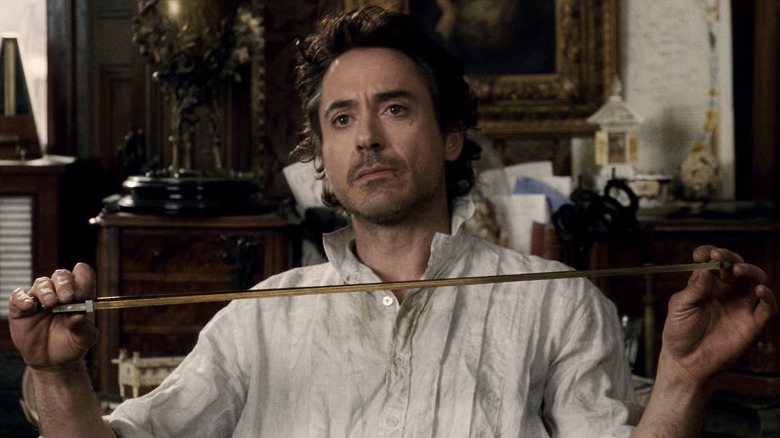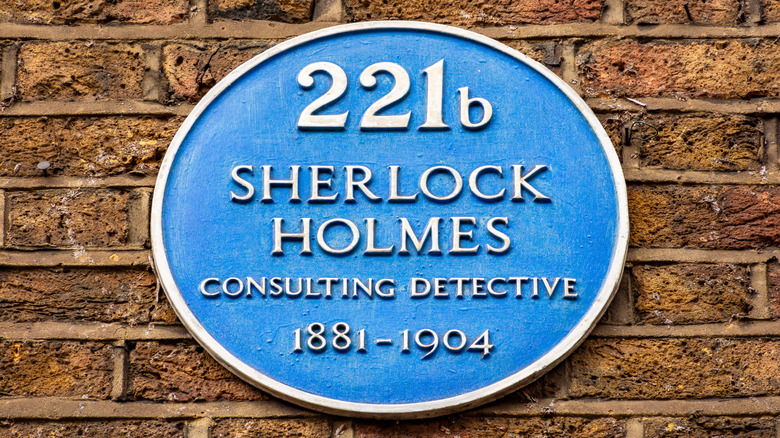Was Sherlock Holmes Based On A Real Person?
Pipe-smoking, funny-hat-wearing detective Sherlock Holmes is the standard by which many beloved sleuths are compared to and understandably so. Created by Sir Arthur Conan Doyle, Baker Street's most beloved resident has been in 56 short stories and 70 films that have adapted his adventures, with some of the best iterations being played by the likes of Robert Downey Jr., Benedict Cumberbatch and Wishbone the dog. But was there ever a real Sherlock Holmes to begin with?
Well, however improbable it may be that there was a detective that battled with hellish Baskerville hounds or mentally dueled an evil mastermind over a waterfall, Doyle's beloved detective was very much inspired by a real person. Born in 1837, Joseph Bell was a Scottish surgeon and lecturer at the University of Edinburgh who taught Doyle for a year during his medical studies and chose him as his outpatient clerk. Doyle came to admire his teacher — so much so that the methods inspired him in the creation of Holmes as well as his likeness.
In Doyle's biography from 1923, "Memories and Adventures" the creator of Sherlock Holmes acknowledged his former mentor and his view of the man physically lines up with how Holmes was often depicted. "Bell was a very remarkable man in body and mind," wrote Doyle. "He was thin, wiry, dark, with a high-nosed acute face, penetrating grey eyes, angular shoulders, and a jerky way of walking." As for Bell's methods in the field. "He was a very skilful surgeon, but his strong point was diagnosis, not only of disease, but of occupation and character."
Arthur Conan Doyle thanked Joseph Bell for Sherlock Holmes
While there might have been disputes about the origins of Sherlock Holmes, an outright message of thanks between a student and teacher confirmed that Bell really was the inspiration behind the world's greatest detective that doesn't dress like a bat. In a letter from Doyle to Bell, the famous author confessed:
"It is most certainly to you that I owe Sherlock Holmes, and though in the stories I have the advantage of being able to place him in all sorts of dramatic positions I do not think that his analytical work is in the least an exaggeration of some effects which I have seen you produce in the outpatient ward."
It's interesting that in the many interpretations of Holmes, one of the most popular is the off-kilter iteration of the character in "House. M.D." Hugh Laurie's anti-social misanthropic medical genius might not be nice to his patients, but he can spot something that might be overlooked by the likes of Wilson (Robert Sean Leonard, as this version's Watson). More importantly, it's in a hospital that House usually finds the game being afoot, the same setting where Doyle found his inspiration all those years ago. But while the inspiration for Holmes might be real, Holmes' actual home wasn't a home at all.
221b Baker Street doesn't exist
Besides the pipe and the deerstalker hat, the other detail synonymous with the astute Sherlock Holmes was the apartment where he cracked many cases with Watson at his side. In Arthur Conan Doyle's short stories, Holmes stayed at 221b Baker Street in London and while it might have seemed easy to pick the location straight off the map, it turns out that the address never existed initially.
Sherlock's home address was first revealed in "A Study in Scarlet," which was published in 1887. However, at that point Baker Street homes only went up to 100, so Doyle actually added on a few more extra doors than the one belonging to his deductive hero. It wasn't until 1932 that the Abbey National Building Society filled the spot between 219-229 Baker Street and even began to receive mail addressed to Holmes — so much mail, in fact, that they hired a receptionist to answer it on a daily basis.
A dispute arose when the Sherlock Holmes Museum opened (between 237 and 241 Baker Street) and argued the case that they should receive the mail as opposed to the bank. It took until 2002 for the issue to be resolved and for the Museum to take over responsibility for letters sent to Mr. Holmes, which is reassuring given that solid evidence points to Mr. Holmes not being real.


